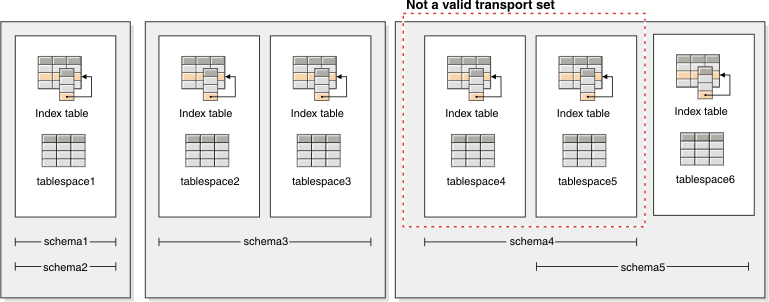Transporting a database schema involves taking a backup image of a database and restoring the database schema to a different, existing database. When you transport a database schema, the database objects in the transported schema are re-created to reference the new database, and the data is restored to the new database.
A database schema must be transported in its entirety. If a table space contains both the schema you want to transport, as well as another schema, you must transport all data objects from both schemas. These sets of schemas that have no references to other database schemas are called transportable sets. The data in the table spaces and logical objects in the schemas in a transportable set reference only table spaces and schemas in the transportable set. For example, tables have table dependencies only on other tables in the transportable set.
It is strongly recommended to check the buffer pools that are assigned to transported table spaces after transport. The statement SELECT SUBSTR(TBSPACE,1,15), BUFFERPOOLID FROM SYSCAT.TABLESPACES can be used to list the assigned buffer pools to a table space.
If necessary, issue the ALTER TABLESPACE command to update the buffer pool.

You can transport database schemas by using the RESTORE command with the TRANSPORT option.
When database schemas are transported, a temporary database is created and named as a part of the transport operation. The transport staging database is used to extract logical objects from the backup image so that they can be re-created on the target database. If logs are included in the backup image, they are also used to bring the staging database to a point of transactional consistency. The ownership of the transported table spaces is then transferred to the target database.
| Database object | Consideration when transporting schemas |
|---|---|
| SQL routines (not external routines using SQL) | A new copy of the SQL routine is created in the target database. For SQL stored procedures, additional catalog space is consumed because an additional copy of the stored procedure byte code is created in the new database. |
| External routines | A new catalog entry is created for each routine. This catalog entry references the same binary file as the original source routine. The RESTORE command does not copy the external routine binary file from the source system. |
| Source tables in states causing access problems | For tables that are not in normal state at the time the backup image was generated, such as tables in check pending state or load pending state, the data from those tables might not be accessible in the target database. To avoid this, you can move the tables to normal state in the source database before schema transport. |
| Tables containing the data capture attribute | Source tables with data capture enabled are transported to the target database with the data capture attribute and continue to log interdatabase data replication information. However, replicated tables do not extract information from this table. The user has the option of registering the new target table to act as a replication source after the RESTORE command completes. |
| Tables using label-based access control (LBAC) | During the transport of data that is protected by LBAC, the transport operation re-creates the LBAC objects on the target database. If LBAC objects of the same name exist on the target database, the transport operation fails. To ensure that restricted data access is not compromised, the transport operation does not use existing LBAC objects on the target database. |
| Temporary table spaces | If there are any system temporary table spaces that are defined with the source backup image and the transport operation excludes them from the table space list, these system temporary table spaces are still created in the staging database but not the final target database. As a result, you need to issue the SET TABLESPACE CONTAINERS command for these system temporary table spaces in order to provide valid containers to complete the restore operation, just as you would for any table spaces that are specified within the table space list. |
When you transport table spaces, a log record with a special format is created on the target database. This format cannot be read by previous DB2 versions. If you transport table spaces and then downgrade to a version earlier than DB2 Version 9.7 Fix Pack 2, then you cannot recover the target database that contains the table spaces that were transported. To ensure that the target database is compatible with earlier DB2 versions, you can roll forward the target database to a point in time before the transport operation.